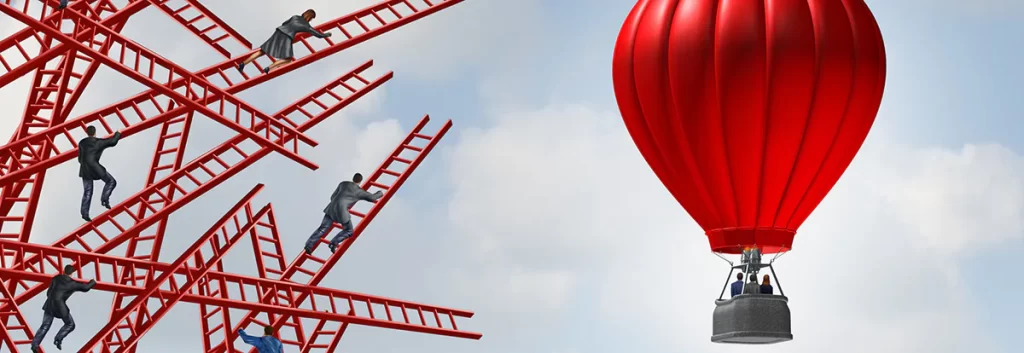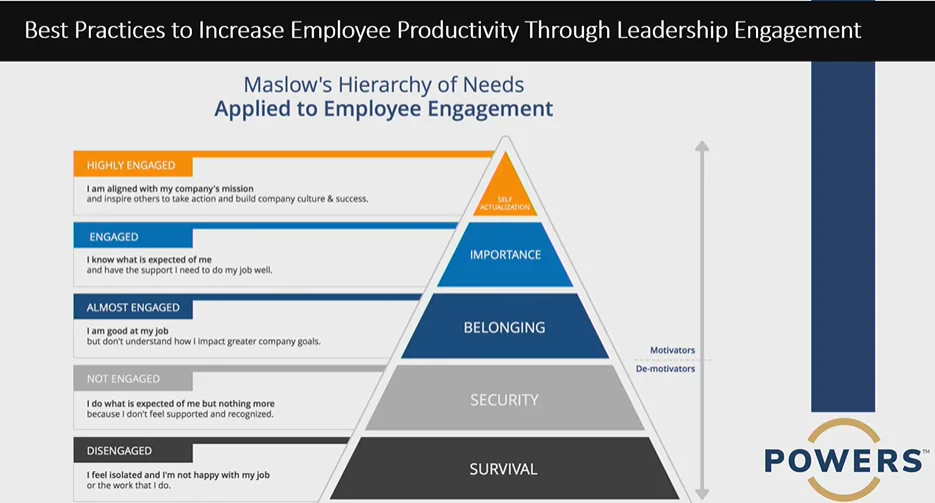
Boosting morale presents a bit of a challenge these days. A recent study reported by Industry Week found that 50 percent of employees surveyed said they were afraid of contracting COVID-19 at work. With an atmosphere this thick with worry, stress, and uncertainty, how can front-line managers step up as effective leaders, assuaging concerns and keeping pace with accelerated production demands?
POWERS Vice President Donte Vaughn and CEO Sean Hart addressed this confounding conundrum in their April 23 webinar, “Coaching Through Crisis,” the final installment of their three-part series, “Panic Is Not a Strategy: How to Maximize Your Business Performance During the Coronavirus Era.”
Over the course of an hour, Vaughn and Hart dug deeply into the problem, presenting some tried and true ways that managers can leverage understanding, transparency, proactive communication, and flexibility to help their teams succeed in the face of unprecedented challenges.
The key to strong management, Vaughn and Hart shared, is to apply “empathy protocols” to your day-to-day procedures.
“By empathy protocols, we don’t mean simply throwing all of your previously established procedures and policies out the window,” Vaughn said. “Instead, think of these as amendments designed to address how to tackle the unforeseen, those emergency or crisis situations that arise without warning like today’s pandemic or other events that may impact how we serve our customers.”
Empathy not only boosts morale; it can boost your bottom line.
Here are six key takeaways from the webinar.
Rule #1: Don’t be stringent
As Lao Tzu said, “A tree that cannot bend will crack in the wind.”
You may already be dealing with off-kilter schedules due to a wide variety of factors: employees contending with illness, lack of childcare, the need to tend to ailing family members, or a myriad of other reasons. We are operating in a time of chaos and hardship.
Some managers may instinctively assume that this implies that they should become more strict and enforce greater consequences for employees who show up late. However, Vaughn and Hart strongly advise supervisors to instead show flexibility when it comes to employee hours and schedules.
“If an employee is five minutes late – are they going to get docked a point? Even though those are the folks that are coming in and diving into the trenches with you?” Hart said. Rigidity only exacerbates the pressure an employee may be under. Instead, seek to understand what’s going on.
Rule #2: Working longer hours? Take more breaks
After enough time on the clock at full speed, every human being will eventually hit a wall and lose energy. It’s no wonder, then, that intermittent pauses during the course of a long work day have been scientifically proven to revive mental and physical capacity and increase productivity.
With that in mind, Hart and Vaughn suggest extending extra regular breaks for your workers whose hours may have ramped up due to increased demand. Not only will these systematic breaks allow employees to mentally recharge, but it will likely result in higher quality and more efficient production overall. It’s a win-win.
Rule #3: Proactive communication is your friend
Frequent and effective communication with employees goes a long way toward fostering trust and accountability.
Take, for example, front-line workers who now need to wear additional protective and precautionary gear — particularly in the food and beverage and medical equipment manufacturing industries. That much more additional prep requires more of an employee’s time.
As a leader, you can immediately acknowledge that you’re aware of, and have accounted for, these extra steps, and outline how you’ll adjust your team’s hourly production goals to compensate. Your team will feel relieved and energized when they hear you’ve got a game plan.
Rule #4: Get creative
We understand the dilemma most companies face when thinking of ways to boost employee morale. You can’t pay higher wages or invest in new tools, because right now you’re just trying to stay afloat financially and get through the crisis at hand. We get it!
How do we implement these strategies even when our budgets and reserves are strapped (not only in a crisis like we’re experiencing now, but in “normal times”)? Vaughn and Hart said it’s all about getting creative. Consider implementing some fun contests, mini “town halls,” or personalized thank-you messages or letters to show your appreciation. Set up an employee “ideas box” (just make sure you have a process set up for delivering feedback/acknowledging input).
These are all subtle but impactful ways to show employees that you recognize the incredible stress and strain everyone is under and see their hard work. No scraping up additional funds in the budget that aren’t there: Just make it thoughtful and consistent.
Rule #5: Under and overachievers both require some extra effort
Even when you’re leveraging all the tools we’ve covered here, there may still be employees who are extremely disengaged. In these cases, Hart said, “The worst thing you can do is avoid them. You want to address them directly, set expectations, and hold them accountable for those performance goals.”
But while disengaged employees may need extra investment, Vaughn and Hart say you should also take care not to ignore your star workers either. High performing employees also need communication and involvement from their supervisors, in the form of encouragement, recognition, and the push to take greater ownership and accountability of the tasks and processes they’re excelling at.
Rule #6: Assembling your “Dream Team”
When putting together your championship lineup (think the 1990s Chicago Bulls), weigh how to put the right people with the right skills into the right spot. Sometimes that might mean that people move toward where their strengths are.

Without venturing down the rabbit hole of Abraham Maslow and his impact on modern psychology, the chart above is one tool that may help you understand and pinpoint where each employee is, where they want to go, and how to get them there.
Leaders should ask: Where are my employees at in their life in general? What have their past experiences been like? Try to glean as much as you can about each individual’s aspirations and setbacks. As Vaughn said: “What happens outside comes inside.”
Tune in for more webinars, blog posts, helpful videos, and more, all part of POWERS’ ongoing efforts to help companies pivot in this disruptive time of pandemic.

